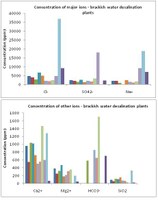Life+ Zelda preparatory actions finished
Action A.1: Data collection of full desalination plants, aimed to evaluate the brine composition of real seawater and brackish water desalination plants in order to study its variability and identify the main factors influencing it. In the execution of this action, data from six different seawater desalination plants and eleven different brackish water desalination plants have been collected and thoroughly compared.
With the data obtained from several real desalination plants and also from scientific papers, it can be concluded that while the brine compositions in the different seawater desalination plants are comparable, the brine obtained in different brackish water desalination plants are noticeably different.
The high variations observed will have an influence on the performance of the EDM-ZLD process. On the one hand, the difference in the total salinity of the brines will have to be considered, so it will affect the EDM stage performance increasing the total current needed to perform the separation and, thus, the total energy consumption. On the other hand, the differences observed for the scale forming ions could also have some negative effects on the EDM stage, so as higher their concentrations higher will be the probability to have membrane scaling problems.
Finally, the compound recovery stage will have to be adapted for each individual case. This fact will have to be considered during the implementation actions of the project in order to cover the widest range of possible scenarios.
Action A.2: Process characterization of Almería seawater desalination plant and El Atabal brackish water desalination plant, was devoted to deeply characterize the desalination processes of the two sites where the new EDM-ZLD technology will be implemented.
First of all a description including the plant dimensions, some details of the desalination process as well as the pre-treatment and post-treatments applied, and also the current brine management strategy, has been performed for the two desalination plants.
Secondly, the seasonal brine composition of both desalination processes has been evaluated. The results obtained in this analysis have clearly shown that the brine obtained in the seawater desalination process present a fairly constant composition during the whole year, which means that the seawater composition does not noticeably change in the different seasons. However, the case regarding the brackish water brine analysis is completely different. In this case, the results obtained have demonstrated the high seasonal variability that these brines present.


